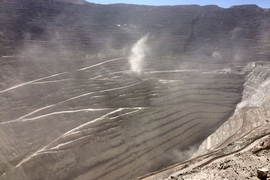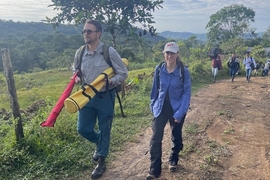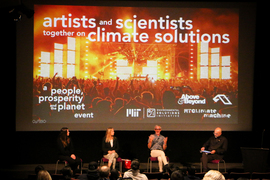Audio
MIT’s Environmental Solutions Initiative (ESI), a pioneering cross-disciplinary body that helped give a major boost to sustainability and solutions to climate change at MIT, will close as a separate entity at the end of June. But that’s far from the end for its wide-ranging work, which will go forward under different auspices. Many of its key functions will become part of MIT’s recently launched Climate Project. John Fernandez, head of ESI for nearly a decade, will return to the School of Architecture and Planning, where some of ESI’s important work will continue as part of a new interdisciplinary lab.
When the ideas that led to the founding of MIT’s Environmental Solutions Initiative first began to be discussed, its founders recall, there was already a great deal of work happening at MIT relating to climate change and sustainability. As Professor John Sterman of the MIT Sloan School of Management puts it, “there was a lot going on, but it wasn’t integrated. So the whole added up to less than the sum of its parts.”
ESI was founded in 2014 to help fill that coordinating role, and in the years since it has accomplished a wide range of significant milestones in research, education, and communication about sustainable solutions in a wide range of areas. Its founding director, Professor Susan Solomon, helmed it for its first year, and then handed the leadership to Fernandez, who has led it since 2015.
“There wasn’t much of an ecosystem [on sustainability] back then,” Solomon recalls. But with the help of ESI and some other entities, that ecosystem has blossomed. She says that Fernandez “has nurtured some incredible things under ESI,” including work on nature-based climate solutions, and also other areas such as sustainable mining, and reduction of plastics in the environment.
Desiree Plata, director of MIT’s Climate and Sustainability Consortium and associate professor of civil and environmental engineering, says that one key achievement of the initiative has been in “communication with the external world, to help take really complex systems and topics and put them in not just plain-speak, but something that’s scientifically rigorous and defensible, for the outside world to consume.”
In particular, ESI has created three very successful products, which continue under the auspices of the Climate Project. These include the popular TIL Climate Podcast, the Webby Award-winning Climate Portal website, and the online climate primer developed with Professor Kerry Emanuel. “These are some of the most frequented websites at MIT,” Plata says, and “the impact of this work on the global knowledge base cannot be overstated.”
Fernandez says that ESI has played a significant part in helping to catalyze what has become “a rich institutional landscape of work in sustainability and climate change” at MIT. He emphasizes three major areas where he feels the ESI has been able to have the most impact: engaging the MIT community, initiating and stewarding critical environmental research, and catalyzing efforts to promote sustainability as fundamental to the mission of a research university.
Engagement of the MIT community, he says, began with two programs: a research seed grant program and the creation of MIT’s undergraduate minor in environment and sustainability, launched in 2017.
ESI also created a Rapid Response Group, which gave students a chance to work on real-world projects with external partners, including government agencies, community groups, nongovernmental organizations, and businesses. In the process, they often learned why dealing with environmental challenges in the real world takes so much longer than they might have thought, he says, and that a challenge that “seemed fairly straightforward at the outset turned out to be more complex and nuanced than expected.”
The second major area, initiating and stewarding environmental research, grew into a set of six specific program areas: natural climate solutions, mining, cities and climate change, plastics and the environment, arts and climate, and climate justice.
These efforts included collaborations with a Nobel Peace Prize laureate, three successive presidential administrations from Colombia, and members of communities affected by climate change, including coal miners, indigenous groups, various cities, companies, the U.N., many agencies — and the popular musical group Coldplay, which has pledged to work toward climate neutrality for its performances. “It was the role that the ESI played as a host and steward of these research programs that may serve as a key element of our legacy,” Fernandez says.
The third broad area, he says, “is the idea that the ESI as an entity at MIT would catalyze this movement of a research university toward sustainability as a core priority.” While MIT was founded to be an academic partner to the industrialization of the world, “aren’t we in a different world now? The kind of massive infrastructure planning and investment and construction that needs to happen to decarbonize the energy system is maybe the largest industrialization effort ever undertaken. Even more than in the recent past, the set of priorities driving this have to do with sustainable development.”
Overall, Fernandez says, “we did everything we could to infuse the Institute in its teaching and research activities with the idea that the world is now in dire need of sustainable solutions.”
Fernandez “has nurtured some incredible things under ESI,” Solomon says. “It’s been a very strong and useful program, both for education and research.” But it is appropriate at this time to distribute its projects to other venues, she says. “We do now have a major thrust in the Climate Project, and you don’t want to have redundancies and overlaps between the two.”
Fernandez says “one of the missions of the Climate Project is really acting to coalesce and aggregate lots of work around MIT.” Now, with the Climate Project itself, along with the Climate Policy Center and the Center for Sustainability Science and Strategy, it makes more sense for ESI’s climate-related projects to be integrated into these new entities, and other projects that are less directly connected to climate to take their places in various appropriate departments or labs, he says.
“We did enough with ESI that we made it possible for these other centers to really flourish,” he says. “And in that sense, we played our role.”
As of June 1, Fernandez has returned to his role as professor of architecture and urbanism and building technology in the School of Architecture and Planning, where he directs the Urban Metabolism Group. He will also be starting up a new group called Environment ResearchAction (ERA) to continue ESI work in cities, nature, and artificial intelligence.










